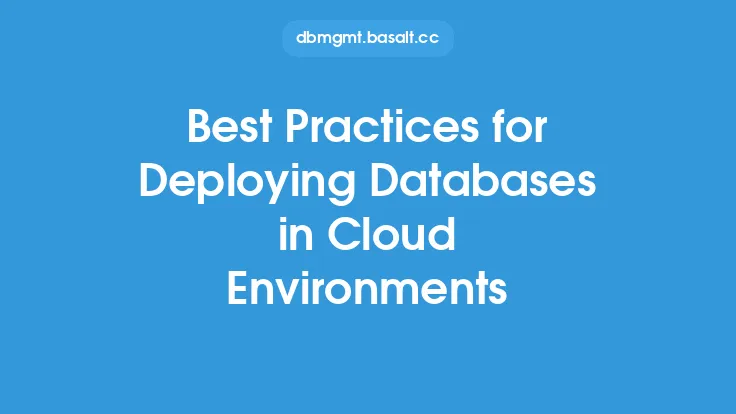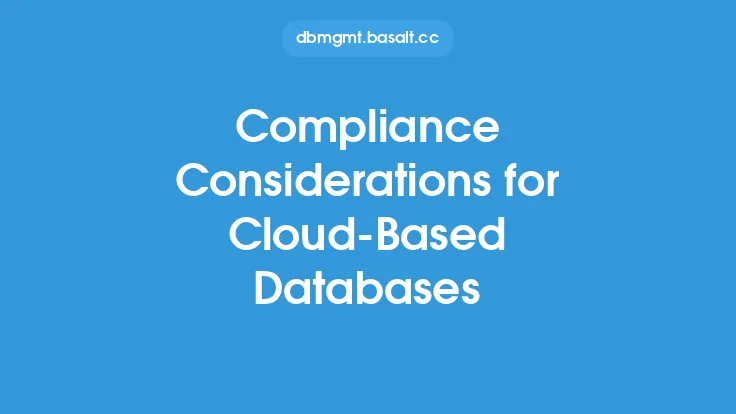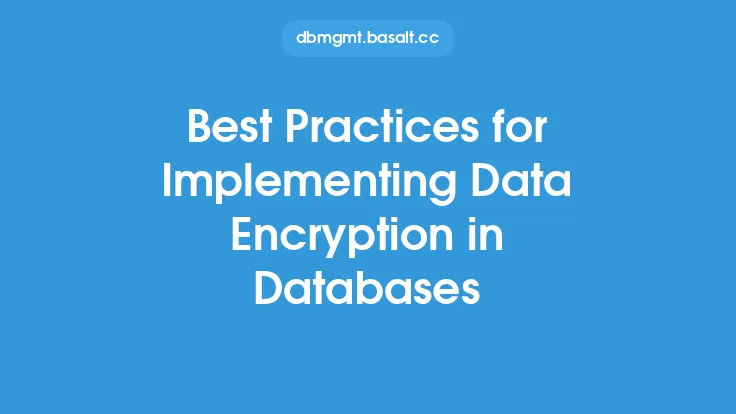When it comes to storing sensitive data in cloud-based databases, encryption is a crucial aspect of ensuring the security and integrity of that data. Cloud-based databases offer a range of benefits, including scalability, flexibility, and cost-effectiveness, but they also introduce new security risks that must be mitigated. Encrypting data in cloud-based databases is essential to protect against unauthorized access, data breaches, and other security threats. In this article, we will explore the considerations and best practices for encrypting data in cloud-based databases.
Introduction to Cloud-Based Database Encryption
Cloud-based database encryption involves converting plaintext data into unreadable ciphertext to prevent unauthorized access. This is typically achieved using encryption algorithms, such as Advanced Encryption Standard (AES) or RSA, which use keys to encrypt and decrypt the data. Cloud-based databases offer various encryption options, including server-side encryption, client-side encryption, and homomorphic encryption. Server-side encryption involves encrypting data on the server-side, while client-side encryption involves encrypting data on the client-side before it is transmitted to the server. Homomorphic encryption, on the other hand, allows computations to be performed on encrypted data without decrypting it first.
Considerations for Encrypting Data in Cloud-Based Databases
When encrypting data in cloud-based databases, there are several considerations that must be taken into account. One of the primary considerations is key management. Encryption keys must be securely stored, managed, and rotated to prevent unauthorized access. This can be achieved using key management services, such as Amazon Web Services (AWS) Key Management Service (KMS) or Google Cloud Key Management Service (KMS). Another consideration is data classification, which involves categorizing data based on its sensitivity and applying appropriate encryption controls. For example, sensitive data, such as financial information or personal identifiable information (PII), may require more stringent encryption controls than less sensitive data.
Best Practices for Encrypting Data in Cloud-Based Databases
To ensure the secure encryption of data in cloud-based databases, several best practices must be followed. One of the best practices is to use a secure encryption algorithm, such as AES-256, which is widely considered to be secure and reliable. Another best practice is to use secure key management practices, such as key rotation and revocation, to prevent unauthorized access. Additionally, data should be encrypted both at rest and in transit, using protocols such as Transport Layer Security (TLS) or Secure Sockets Layer (SSL). Regular security audits and penetration testing should also be performed to identify vulnerabilities and ensure the security of the encrypted data.
Cloud-Based Database Encryption Techniques
There are several cloud-based database encryption techniques that can be used to protect sensitive data. One technique is transparent data encryption (TDE), which involves encrypting data at rest without requiring changes to the application. TDE is supported by many cloud-based databases, including AWS Aurora and Google Cloud SQL. Another technique is column-level encryption, which involves encrypting specific columns of data, such as credit card numbers or passwords. This technique is useful for protecting sensitive data that is stored in specific columns. Additionally, cloud-based databases may offer encryption at the row level or table level, which involves encrypting entire rows or tables of data.
Cloud Provider Encryption Options
Cloud providers offer various encryption options for protecting data in cloud-based databases. For example, AWS offers AWS KMS, which is a fully managed service that enables users to easily create and control the encryption keys used to encrypt their data. Google Cloud offers Google Cloud KMS, which is a managed service that enables users to create, use, rotate, and manage encryption keys. Microsoft Azure offers Azure Key Vault, which is a cloud-based service that enables users to securely store and manage encryption keys. These services provide a range of features, including key creation, key rotation, and access control, to help users manage their encryption keys and protect their data.
Compliance and Regulatory Requirements
Encrypting data in cloud-based databases is not only a security best practice, but it is also a compliance and regulatory requirement. Many regulations, such as the General Data Protection Regulation (GDPR) and the Payment Card Industry Data Security Standard (PCI DSS), require organizations to protect sensitive data using encryption. Additionally, organizations may be required to comply with industry-specific regulations, such as the Health Insurance Portability and Accountability Act (HIPAA) for healthcare organizations. To ensure compliance, organizations must implement encryption controls that meet the relevant regulatory requirements, such as using secure encryption algorithms and managing encryption keys securely.
Conclusion
In conclusion, encrypting data in cloud-based databases is a critical aspect of ensuring the security and integrity of sensitive data. By following best practices, such as using secure encryption algorithms and managing encryption keys securely, organizations can protect their data from unauthorized access and ensure compliance with regulatory requirements. Cloud providers offer a range of encryption options, including server-side encryption, client-side encryption, and homomorphic encryption, to help organizations protect their data. By understanding the considerations and best practices for encrypting data in cloud-based databases, organizations can ensure the secure storage and transmission of sensitive data in the cloud.





